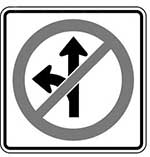Prohibited Turns
Disobey Sign Offences
 Signs are placed to control or direct the flow of traffic by a municipality or city.
Signs are placed to control or direct the flow of traffic by a municipality or city.
The municipalities may create municipal bylaws and place signage for traffic control as they see fit.
Where signs are placed and erected controlling the flow of traffic, drivers shall obey the signs.
The enforcement of traffic signs is covered within 2 sections of the Highway Traffic Act and within each municipalities by-laws.
Offences
Prohibited Turns are traffic tickets such as:
- Proceed contrary to sign at intersection – Highway Traffic Act 144.9
- Disobey sign – Highway Traffic Act 182.2
- Disobey sign – Municipal By-law
- must occur at an intersection
- has 2 demerit points
- goes on driving record and insurance
- can occur anywhere
- has 2 demerit points
- goes on driving record and insurance
Disobey Sign – Bylaw
- can occur within a municipality
- has 2 demerit points
- goes on driving record and insurance
- in the City of Toronto the fine is $18the fine is set by the municipality
Traffic control signs must be clear and be unobstructed to traffic.
Fines
The fine for disobey a sign or fail to proceed as directed is usually $110.00.
Insurance Implications
A conviction on the drivers abstract for a disobey sign charge can affect insurance rates.
Though there maybe have been nothing dangerous or unsafe with the movement disobey sign ticket can affect insurance rates.
Insurance companies believe that drivers convicted of traffic offences are at a higher risk of being involved in a traffic accident and submitting a claim.
Drivers Abstracts/Records
Driving abstracts are available to anyone who has the drivers licence number for a fee payable to the Ministry of Transportation.
Therefore the way the insurance company will finds out about the ticket is:
- The insurance company contacts
- the Ministry of Transportation and
- checks the drivers abstract, or
- the driver calls and
- tells the insurance company that they received a ticket
Where a driver is convicted of speeding the conviction is put on the driving record for 3 years.
What is a Victim Fine Surcharge?
The provincial government adds a victim fine surcharge (VFS) like a tax to every non-parking fine imposed under the Provincial Offences Act.
The victim fine surcharge for most sign offences is $20.
These funds are deposited into a special fund to help victims of crime.
Licence Suspensions
There are no licence suspensions for disobeying a sign.
Unpaid fines
All drivers maybe suspended where a fine goes into default.
Where a drivers licence is suspended for an unpaid fine, the licence will be suspended until the payment is made to the court.
The reinstatement fee is $281.00
Demerit Point Suspensions
The accumulation of demerit points can result in a licence suspension.
- Class G licences receive a
- drivers licence interview at 8 points
- licence suspension at 15 demerits
- Class G1 and G2 Drivers are suspended for
- accumulating 6 demerit points
- any one ticket with 4 or more demerit points
Legal Definition
Traffic control signals and pedestrian control signals 144 (1)
Signs
(9) The provisions of this section are subject to any sign, as prescribed by the regulations, forbidding a left turn, right turn, through movement or combination thereof that is posted at an intersection and every driver shall obey every such sign.
Regulations, signs and markings
182 (1) The Lieutenant Governor in Council may make regulations requiring or providing for the erection of signs and the placing of markings on any highway or any type or class thereof, and prescribing the types of the signs and markings and the location on the highway of each type of sign and marking and prohibiting the use or erection of any sign or type of sign that is not prescribed.
Signs to be obeyed
(2) Every driver or operator of a vehicle or street car shall obey the instructions or directions indicated on any sign so erected.
“driver” includes an operator of a street car;
“emergency vehicle” means,
(a) a vehicle while used by a person in the lawful performance of his or her duties as a police officer, on which a siren is continuously sounding and from which intermittent flashes of red light or red and blue light are visible in all directions, or
(b) either of the following vehicles, on which a siren is continuously sounding and from which intermittent flashes of red light are visible in all directions:
(i) a fire department vehicle while proceeding to a fire or responding to, but not while returning from, a fire alarm or other emergency call, or
(ii) an ambulance while responding to an emergency call or being used to transport a patient or injured person in an emergency situation;
“intersection” includes any portion of a highway indicated by markings on the surface of the roadway as a crossing place for pedestrians; (“intersection”)
“pedestrian” includes a person in a wheelchair;
“vehicle” includes a street car.
Where to stop — intersection
(5) A driver who is directed by a traffic control signal erected at an intersection to stop his or her vehicle shall stop,
(a) at the sign or roadway marking indicating where the stop is to be made;
(b) if there is no sign or marking, immediately before entering the nearest crosswalk; or
(c) if there is no sign, marking or crosswalk, immediately before entering the intersection.
Where to stop — non-intersection
(6) A driver who is directed by a traffic control signal erected at a location other than at an intersection to stop his or her vehicle shall stop,
(a) at the sign or roadway marking indicating where the stop is to be made;
(b) if there is no sign or marking, immediately before entering the nearest crosswalk; or
(c) if there is no sign, marking or crosswalk, not less than five metres before the nearest traffic control signal.
Yielding to pedestrians
(7) When under this section a driver is permitted to proceed, the driver shall yield the right of way to pedestrians lawfully within a crosswalk.
Yielding to traffic
(8) When under this section a driver is permitted to proceed, he or she shall yield the right of way to traffic lawfully using an intersection or, where traffic control signals are erected where a private road or driveway meets a highway, lawfully using the area controlled by the traffic control signals.
Case Law
R. v. Petruzzo, 2011 ONCA 386 (CanLII)
2011-05-17 | 2 pages | cited by 1 document
bilingual — traffic signs — passed a by-law — sign — intersections
[…] [1] Mr. Petruzzo was convicted of disobeying a traffic sign contrary to s. 182(2) of the Highway Traffic Act, R.S.O. 1990 c. H-8 . […] [3] Mr. Petruzzo raises two grounds of appeal: 1) he should have been charged under s. 144(9) of the Highway Traffic Act , which specifically prohibits turns at intersections; and 2) his conviction was invalid because the sign prohibiting a right-hand turn at Bay and Richmond was in English only, instead of in both English […] Because it has not done so, s. 52 of Regulation 615 under the Highway Traffic Act applies and forecloses the need for bilingual traffic signs. […]
West Nipissing (Municipality) v. Langlois, 2018 ONCJ 802 (CanLII)
2018-11-02 | 13 pages
traffic sign — actus reus of the offence — presumption — existence of the by-law — compliance
[…] [1] Mr. Guy Langlois was charged with disobeying a sign contrary to s. 182 (2) of the Highway Traffic Act, R.S.O. 1990, c.H.8 (“HTA ”). […] As a result, Mr. Langlois was stopped and charged with disobeying a sign, contrary to s. 182 (2) of the HTA . […] [15] In R. v. Neinstein, 2007 Carswell Ont 5473 (ONCJ) , the prosecution, the defence and the appeal judge all agreed that the traffic sign did not comply with the regulations and that the defendant was wrongfully convicted of disobeying a sign contrary to s.182(2) of HTA . […]


